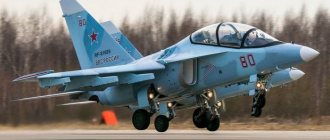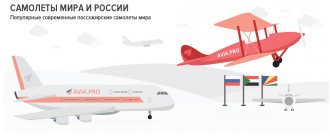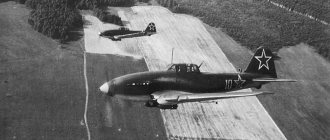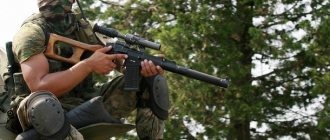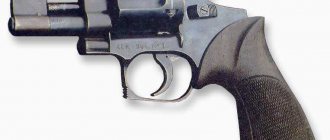The Aviation Complex named after S.V. Ilyushin is one of the leading enterprises in Russia in the field of aviation technology development. Full name: Open Joint-Stock Company “Aviation Complex named after S.V. Ilyushin.” Previously called plant No. 240. Located in Moscow.
General Designer, also known as General Director: Livanov Viktor Vladimirovich - laureate of the State Prize of the Russian Federation.
JSC Aviation Complex named after Ilyushin was opened in 1933. According to the order of the head of the Main Directorate of Aviation Industry P.I. Baranov on the basis of the plant named after. Menzhinsky formed the Central Design Bureau for experimental aircraft construction of military aircraft and light aviation.
The post of head of the Central Clinical Hospital was entrusted to Sergei Vladimirovich Ilyushin. Under his leadership, the design bureau began to occupy a leading position in the construction of complex aircraft among similar enterprises in the USSR.
The results of this design bureau are impressive. Over the 80 years of its existence, over 200 and more than 120 different types of aircraft were developed within its walls. During this time, the factories involved in the production of Ilyushin aircraft produced over 60,000 units of Il aircraft. The main features that distinguish the products of this brand are a high degree of reliability, manufacturability, simplicity of design, convenient maintenance and piloting, and a long service life. The company at different times produced aircraft for various purposes. These included attack and bomber aircraft, special purpose aircraft, military transport aircraft, passenger aircraft and others.
KB named after Ilyushin, with its developments of front-line attack fighters and bombers, made a significant contribution to the victory of the USSR in World War II.
During the Great Patriotic War, the country's military fleet consisted of 30% of Il-10 and Il-2 attack aircraft and Il-4 long-range bombers. In the post-war period, the Il-28 became the first mass-produced model of the USSR Air Force jet bomber.
Father's house and service in the army of the Russian Empire
Ilyushin Sergei Vladimirovich was born in 1894 on March 30 (new style) in a poor peasant family and his biography as a child is similar to thousands of others. His native village was located in the Vologda province.
At the age of 8, like his older brothers, he constantly worked part-time, helping his mother and father. At the same time, he diligently studied at the parish school, where by the age of 6 he learned to write and read. In the future, the designer more than once recalled with a kind word his first teacher, who instilled in him a love of learning.
Before being drafted into the Imperial Army, he changed many professions:
- Assistant driver;
- Laborer in factories;
- He built a railroad and many others.
In 1910, on the advice of his fellow countrymen, he got a job as a navvy at the Kolomyazhsky hippodrome, which was actively being converted into an airfield. The work proceeded at an accelerated pace - the first International Air Festival in Russia was planned for the fall.
There the young guy saw performances of famous aviators gracefully flying biplanes.
The spectacle of technology soaring in the sky turned the fate of Sergei Vladimirovich upside down.
In 1914, Russia entered the war with the Axis powers and twenty-year-old Sergei was drafted into the armed forces. After training in an infantry company, he was sent to serve in Vologda. There he served as a clerk in a local military unit.
Afterwards, he volunteered and was transferred to the hangar at the Commandant airfield. Gradually, Ilyushin rose to the rank of senior mechanic and was engaged in the repair and maintenance of the S-22 Ilya Muromets. In the summer of 1917 he graduated from the soldier's piloting school, and in 1918 he was demobilized.
Modernity
As a result of the collapse of the USSR, Russia was left without military transport aviation. The construction of most of these machines was carried out in Kyiv, and their mass production was established in different cities of Ukraine and Uzbekistan, even the Il-76 was produced in Tashkent. To rectify the situation, it was decided to establish production of Il family aircraft in Russia.
The modernized Il-76MD-90A aircraft made its first flight in 2014 from the Vostochny airfield in Ulyanovsk. In parallel with this, the problem of reproducing the tanker, which took off in 2018, was solved.
In addition to modernization work, the design bureau is completing the design and preparing the first flight of the new light military transport aircraft Il-112V.
Of course, the Ilyushin company team is also involved in maintaining the airworthiness of operating aircraft, both in the country and abroad. They are being modernized.
Start of work in the Red Air Fleet
In 1919, Ilyushin was drafted into the Red Army and sent to Serpukhov. After some time, he was transferred to serve as a mechanic on the so-called air train (a train, which is a mobile repair platform for aircraft).
Later, in the fall, he participated in the evacuation of a damaged enemy Avro 504, which in the future became the basis for the U-1 training biplane.
Having become the head of an air train, in 1921 he decided to enter the Institute of Engineers of the KVF. Sharing his memories, the creator of “Flying Tanks” admits that he passed the exams with C grades.
The experience gained over the years in the army helped me to enroll. He combined his studies with work in a gliding circle, where he designed and implemented several samples:
- “Mastyazhart”;
- “Rabfakovets”;
- “Mastyazhart - 2”;
- "Moscow".
The last glider was created in 1925 and, piloted by pilot Konstantin Artseulov, was presented at the Rhone competitions in Germany. A year later, Ilyushin brilliantly defended his graduation project on the creation of a fighter aircraft.
Forge of records
For the rest of his life he had a reminder of those flights - a scar. He is visible in photographs of Ilyushin - it is difficult not to pay attention to his raised eyebrow. Since 1936, Ilyushin has been the chief designer of the design bureau at the Menzhinsky Aviation Plant. Since then, he has succeeded in almost everything.
It is difficult to imagine a more impeccable and happy fate. He was valued by his colleagues, feared and respected by his students, and favored by the authorities. Stalin once even invited the aircraft designer to stay for several days at the famous Kuntsevo dacha. The love of a leader is a double-edged value; at any moment it could turn against the favorite. But the General Secretary believed in Ilyushin. Perhaps because he saw a strong character in him.
Ilyushin
Sergey Ilyushin
Photo: commons.wikimedia.org
Height around: how the first Russian aviator school became elite
Why did the anniversary of the Kachin Flight School turn into a sad holiday?
His whole life flowed from plane to plane, step by step. He had a commandment: “If you want to do something serious, you won’t get anything done in eight working hours.” Sometimes it seemed that Ilyushin simply did not notice anything else - only drawings and production. Only work. No everyday disasters, no deviations from the course. But each aircraft is a whole story, from plans and disputes to implementation and testing. And then - release, and then - improvements and, finally, the idea of the next model. The idea covered the entire Soviet industry - after all, Ilys were produced in Kazan, Tashkent, and Minsk... And the entire globe, which Ilyushin’s planes flew over thousands of times.
On July 17, 1936, test pilot Vladimir Kokkinaki set the first Soviet aviation record, officially registered by the International Aeronautical Federation, using the Ilyushin TsKB-26 machine. This was an altitude record for a land aircraft with a payload of 500 kg. The previous achievement of the Frenchman Signerin Kokkinaki surpassed it by 1173 m, rising to a height of 11458 m.
Ilyushin
Record-breaking pilot Vladimir Kokkinaki near his TsKB-26 aircraft
Photo: RIA Novosti/Boris Vdovenko
Russian hero and flying boat: the largest aircraft in the world
Stories of the main air giants and a visual comparison of their characteristics and scales
And then the records came in a string. The most famous was the flight from Shchelkovo near Moscow to Spassk-Dalniy on a TsKB-30 bomber, which lasted more than a day. This was a flight range record - 7580 km. Both Kokkinaki and navigator Alexander Bryandinsky were then awarded the title of Hero of the Soviet Union. Ilyushin was left without a star that time.
Career: Beginning and ending
An engineer who has successfully completed his training is appointed chairman of the group of experts of the Air Force Scientific and Technical Committee (previously KVF), where he studied the experience of foreign colleagues and developed technical requirements for aircraft.
In particular, he made adjustments to the works of Tupolev and Polikarpov. But the main goal of life remained airplanes.
In 1931, Ilyushin submitted a report asking to be transferred to the aviation industry.
From 1931 to 1933 he served as head of TsAGI (Central Aerohydrodynamic Institute). After a series of proposals and reshuffles, the OKB (Experimental Design Bureau) was formed, which the future Hero of Labor headed, and his dream came true.
He headed the OKB until 1970, when he was forced to retire due to illness. The last swallow to emerge from under Ilyushin’s wing was the Il-62 passenger airliner. Behind us were other lines of Il aircraft: attack aircraft, bombers.
The designer’s contribution to modern aircraft construction is colossal, and the design bureau he founded continues to produce high-quality, world-class aircraft.
Military transport aircraft
In addition to the civilian theme, which became the main one for the design bureau, the Il-76 military transport aircraft was developed. It was the first aircraft of its class to be powered by turbojet engines, making its maiden flight in 1976.
The military, accustomed to the classic An-brand propeller-driven military transport aircraft, initially resisted quite strongly the adoption of this aircraft for service. However, over time, the Il-76 proved itself to be the best, receiving the affectionate name “Ilyusha” among the troops. To this day, it remains the main military transport aircraft of the Russian Aerospace Forces.
Based on the Il-76, a large number of modifications were developed to solve a variety of problems. In addition to purely transport and military aircraft, the Il-78 tanker was developed, as well as the A-50 AWACS; the machine was used for training astronauts in zero gravity, explored the Arctic and Antarctic, and extinguished forest fires.
Family
He was married twice and had 4 children.
First wife - Raisa Zhalkovskaya (1897 - 1972).
Children:
- Daughter Irina (1920 – 2007). Wife of Academician Orekhovich;
- Son Vladimir (1927 – 2010). He became a pilot and then tested aircraft prototypes. Honored Hero of the USSR.
Second wife - Anastasia Vasilievna Sovetova (1915-2008). She worked in a design bureau as a design engineer.
Children:
- Sergei Sergeevich Ilyushin (1947 – 1990). Aircraft engineer;
- Son Alexander was born in 1955. Aviation engineer.
Cheap but reliable
Immediately after the war, Ilyushin was captured by peaceful projects. Of course, he continued to develop combat aircraft, but he devoted more and more time and effort to passenger aviation. Even during the war days, he began to sketch cars for a peaceful future, when travel would become more important than bombing.
This is how the IL-14 appeared, which had many modifications and became famous for its participation in dangerous expeditions - in the Arctic, in Antarctica. He remained indispensable in polar aviation for a long time. Such aircraft were used both on the world's first polar voyage of the nuclear icebreaker Arktika, and on the famous ski trips to the North Pole, supporting travelers from the sky. The next machine of the Ilyushin Design Bureau, the four-engine turboprop Il-18, became one of Aeroflot’s main long-haul aircraft for a decade and a half. In April 1959, the Il-18 began to operate regular flights to Adler and Alma-Ata.
Ilyushin
Il-14 plane flies over ice in the Central Arctic
Photo: RIA Novosti/B. Vdovenko
What to fly towards the century
Domestic civil aviation celebrates its 95th anniversary
In the early 1960s, the government set a task for designers: to create a world-class passenger jet that could fly non-stop from Moscow to the Far East and Havana. Ilyushin took up the matter. The intercontinental airliner Il-62, according to the then tradition, was put into operation on the festive date - the 50th anniversary of the October Revolution. For a long time, the Il-62 was also the official government aircraft for the heads of the Soviet Union and Russia. And in our time, the leader of North Korea, Kim Jong-un, uses one of the two Il-62Ms belonging to Air Koryo as his personal aircraft.
Ilyushin had a motto: “Simple, but high quality, cheap, but reliable!” Here the innate peasant practicality helped. Ilyushin was proud that he had two to three times fewer employees than in the “Tupolev company.” Aircraft designers in the USSR were a privileged caste - and, as they say, they usually did not hesitate to reach into the state pocket for an extra ruble. And for Ilyushin, profitability was also a matter of honor.
Photo: RIA Novosti/Ivan Shagin
Sergey Ilyushin
He did not favor journalists - he did not like to pose or give interviews, and even remained silent at meetings of the Academy of Sciences. He valued his time too much. He avoided idleness and noise. He felt at ease only when he was in the thick of design work. Everything else was swept aside as much as possible.
The first female record holders in the history of world aviation
Their stories - on the 120th anniversary of the birth of the legendary pilot Amelia Earhart
For his punctuality and smartness, his colleagues called him a clean guy. Ilyushin was convinced that a reliable aircraft begins with the internal discipline of the designer, and he remained true to his habits for decades. And for his ability to bring any innovative project to the level of technological clarity, Ilyushin was considered a master of simple solutions.
Interesting and unusual facts from life
- In April 1938, an accident occurred. The UT-2, piloted by Ilyushin, suffered an engine failure. I had to land the car in pitch darkness and, upon landing, it turned over. The pilot and passenger (Ivan Vasilyevich Zhukov) escaped with minor injuries;
- By the way, after this disaster, an order was given in which it was written in black and white: “Chief designers of the design bureau are prohibited from piloting aircraft independently”;
- There was fierce competition between the Design Bureau and the Tupolev Design Bureau in the development of short- and long-range bomber aircraft. As a result, S.V. Ilyushin’s aircraft supplanted Tupolev’s designs from civil aviation.
Prospects
Ilyushin's new aircraft include, first of all, military transport aircraft. Options for the layout of the Il-276 are being studied. In the near future, it is planned to carry out research work to determine the appearance of the Ilyushin super-heavy transport aircraft, which should surpass the aging An-124.
Work is also underway to resume production of the Il-96, but in a new modification - the Il-96-400, close to the original appearance of this aircraft with an extended fuselage and new engines, as well as the regional Il-114, previously produced in Tashkent.
Plans have emerged, together with relevant organizations, to develop reusable systems for low-Earth orbit.
All OKB aircraft designed under the leadership of Ilyushin
The model range of designed and produced aircraft of the Il brand was divided into 3 branches:
- Stormtroopers;
- Long-range bombers;
- Civil aircraft.
The design bureau's developments were distinguished by their simplicity of design and high reliability, achieved through painstaking work and high creative potential of the head of the design bureau.
People who worked with him noted the lively character and hard work of their boss. He competently distributed responsibilities among the staff and achieved incredible results.
Ilyushin's front-line attack aircraft showed themselves with dignity during the Great Patriotic War.
Produced in incredible quantities, they completely covered the needs of all fronts. The closest analogues were the German Ju-87 and the American P-47 Thunderbolt.
- IL–2/2m . Initially, it was planned to put into production a version with a two-seat cockpit: a pilot and a gunner-radio operator. Due to problems with alignment, the second cockpit was removed and put into production without a firing point, behind the pilot's back.
The device carried up to a ton of bomb load under its wings, could be equipped with NURs (unguided rockets), and was often armed with 23 mm and 37 mm cannons.
In 1943, modification 2m was released. The gunner-radio operator who controlled the turret was returned to it. Ilov's losses have decreased. Produced: 36,000 pcs.
- IL-10 . Developed during WWII. It was a development of the idea of a stormtrooper. It had enhanced armor, superior firepower and a high payload. The vehicle was introduced into series towards the end of the war. Produced: 6160 pcs.
Long-range or strategic bombers are the largest military aircraft and carry the heaviest bomb load.
Ilyushin Design Bureau gave the green light to several machines of this class. Analogs: British Wellingtons, American B-17s.
- IL-4 (DB-3f) . Twin-engine long-range bomber. The workhorse of the Air Force, produced in the amount of 5250 copies. The vehicle had good defensive weapons and carried up to 2.5 tons of payload.
It could also carry torpedoes to attack the enemy. She took part in the raid on Berlin in the summer of 1941.
- IL-28 . Produced since 1949 and produced in the amount of 6100 pieces. This is a new generation jet bomber. Developed using the latest technologies.
Carried both simple bombs and tactical nuclear weapons. He stood guard over the borders of not only our Motherland, but also Poland and China. Combat load - 5 tons. 23 mm guns were installed at the firing points.
Passenger airliners deserve special mention. Ilyushin thought about civilian cargo transportation in the middle of the Great Patriotic War.
Anticipating the need for such aircraft, the Bureau began to create a new aircraft: the Il-12. The requirements placed on a peacetime aircraft were strikingly different from the needs of military aviation in a situation of full-scale war.
The aircraft was used to transport passengers and was used as a transport aircraft. It set world records for non-stop flight distance.
At the same time, the cabin accommodated from eighteen to thirty-two people. The three-point arrangement of the landing gear with the front wheel under the pilot's cabin reduced the length of the runway (runway) required for takeoff or landing.
IL-12 became the first, but not the last, peaceful worker. Subsequently, Ilyushin’s team released many more cars, delighting their ideological inspirer and permanent leader. S.V. Ilyushin died on February 9, 1977. The work of his hardworking hands is still alive.
Training base
The educational institution began its existence on April 1, 1998. More than 3,200 people took advanced training courses under him. The lectures are given by the IL aircraft designers themselves, which ensures high-quality learning results. All masters training future employees confirm their qualifications with the appropriate certificate.
At the training base of OJSC "IL" there are the following facilities for training aviation personnel:
- • classrooms;
- • flight control system stand;
- • chassis stand;
- • automatic training system;
- • simulator of cabin procedures;
- • library, including operational and technical documentation, educational and methodological literature and a reading room;
- • development and flight testing bases of the enterprise in the city of Zhukovsky and the cities where representative offices of customer airlines are located.
Aircraft of OKB "Il"
| PAK TA |
| IL-2 |
| IL-4 |
| IL-6 |
| IL-8 |
| IL-10 |
| IL-12 |
| IL-14 |
| IL-16 |
| IL-18 |
| IL-20 |
| IL-22 |
| IL-24 |
| IL-28 |
| IL-30 |
| IL-32 |
| IL-38 |
| IL-40 |
| IL-46 |
| IL-54 |
| IL-62 |
| IL-76 |
| IL-78 |
| IL-80 |
| IL-86 |
| IL-90 |
| IL-96 |
| IL-102 |
| IL-103 |
| IL-106 |
| IL-112 |
| IL-114 |
| Il-214 |
Performance characteristics
The Il Sturmovik was produced in several different modifications, which were noticeably different from each other.
Their characteristics were also different:
| IL-2 single seat | Il-2 KSS (double) | IL-2 NS-37 | |
| Takeoff weight | 5.31 tons | 6.16 tons | 6.16 tons |
| Empty weight | 3.99 tons | 4.36 tons | 4.625 tons |
| Aircraft length | 11.6 m | 11.6 m | 11.6 m |
| Height | 4.17 m | 4.17 m | 4.17 m |
| Wingspan | 14.6 m | 14.6 m | 14.6 m |
| Engine power | 1575 hp | 1720 hp | 1720 hp |
| Maximum speed | 450 km/h at altitude, 433 km/h at ground level | 414 km/h at altitude, 403 km/h at ground level | 405 km/h at altitude, 391 km/h at ground level |
| Flight range with load | 638 km | 720 km | 685 km |
| Service ceiling | 7,800 m | 5,500 m | 6,000 m |
| Normal bomb load | 400 kg | 400 kg | 100 kg |
The horizontal maneuverability of the Il-2 was low, especially in the heavier two-seat version. Even without bombs, the plane completed a full turn in 27 seconds.

